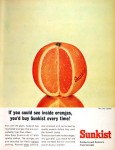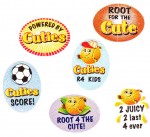a little sticker makes a big difference
The other day I found myself doing something quite curious – after having placed an item into my grocery cart, I turned around, took it out, and returned it to the shelf. That momentary act wasn’t strange because I’m generally a decisive person — but rather because of what caused me to reverse my actions. My change of heart was prompted by a ½” inch square – or actually, the absence of it.
You see, the product was a box of tangerines and none of contents had a Cuties sticker like the ones I had noticed on tangerines I had purchased previously. In the split second of surveying the item, I realized they were in fact a different brand of tangerines and so I decided I didn’t want them. I stopped to consider what had just happened – and it got me thinking about the role of brands and commodity categories.
an orange is just an orange
Generally speaking, produce is not a category in which brands have played a strong role. Sure, Sunkist oranges
and Chiquita bananas
have been promoted through the years, but most category behavior is driven by price – and in more recent years, by source — organic vs. not or locally-grown vs. not.
But lately, I’ve noticed a trend toward more branded produce. In addition to Cuties tangerines, products like Cherub tomatoes and Bunny Luv carrots have sprouted up. In many cases, these branded products cost more than their “generic” counterparts – and yet, despite these recessionary times, people seem willing to pay for them.
It’s curious, especially given the recent growth of private label product. In practically every other aisle of the grocery store, manufacturers’ brands are feeling the pressure from the store’s brands – the increased quality and consumer acceptance of private label is causing branded goods to lose facings or lower their prices. But in produce, the reverse seems to be happening.
why branded produce
This trend seems to be fueled by the intersection of the needs of the consumer with the needs of the retailer. Articles (1, 2) from Grocery Headquarters magazine explain what’s going on:
Seth Pemsler, vice president, retail/international for the Idaho Potato Commission, based in Eagle, Idaho, says consumers want to buy branded produce in the same way they want to buy certain brands of packaged items. “The whole essence of brands is confidence and comfort; the idea that if I buy this brand it’s going to be consistent.”
“Intensifying competition among supermarket chains and constant price wars over center store items have led supermarket retailers to try to differentiate themselves from the competition through the use of their perishable departments, including produce, analysts say.” Further, “consumer research continually emphasizes the importance of great produce departments as the primary criteria for selecting a supermarket to shop,” says Bill Goldfield, communications manager for Dole Food Co., based in Westlake Village, Calif.
Consumers are looking for the quality reassurance which brands promise, and retailers are looking for ways to differentiate themselves and give people reasons to choose them. These complimentary needs have created a win-win-win situation. Produce companies, consumers, and retailers all benefit from the rise of branded produce.
So it’s likely we’ll see even more branded produce in the future. I just hope produce brands don’t exploit the situation and end up upsetting the apple cart of mutual-benefit.
what works
The Cuties brand actually strikes the balance well. A few observations:
- competitive pricing – I’ve found Cuties to be priced only around 10% of above other unbranded options – and with a coupon, the price differential becomes minimal. It’s clear the company behind the brand understands the price expectations of its target.
- perceptible product quality differential – Cuties are noticeably different from other tangerines because they’re sweet, juicy, and seedless. The brand has come to embody this quality difference.
- well-executed brand personality – It’s not simply the use of a brand name that distinguishes Cuties, it’s the brand name itself. “Cutie” is a perfect descriptor of the little orange balls and the name adds value to the product beyond tangible attributes. Further the stickers on every tangerine reinforce the cute brand personality with phrases like “Root for the Cute” and “Cuties R4 Kids.”
Without these elements, Cuties would be just another brand name slapped on an undifferentiated product. But with them, Cuties provides a great example of how brands create value.
related post:


